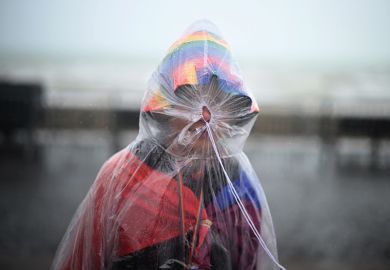What do we mean when we talk about “terror”? How does it differ from “terrorism” or concepts such as horror, dread, fear or panic? Since 9/11, “terror talk” has become commonplace among commentators of every political persuasion. The word has been deployed in so many contradictory ways that it is difficult to know what is really being alluded to. What explains the popularity of “terror”, and why has its meaning changed over time?
These are some of the questions that literary scholar David Simpson attempts to answer in States of Terror. It is an exhaustive and exhausting account. He has studied dozens of literary and philosophical texts; he has reviewed a daunting array of political commentary. His main interest, though, is in philology, or providing readers with a history of rhetorical and linguistic change concerning “terror”.
There are some clear landmarks: for example, the French revolutionary terror of the 1790s, the “Red Terror” of 1917 and Nazi terror. But there are other traditions, as well. In theological texts, for example, “terror” was often believed to be good as well as necessary. It was an “essential contributor to appropriate reading or beholding”, we are told. In literatures of the sublime, “terror” was also essential. Simpson maintains that if the aesthetics of sublime terror “requires being at a secure distance from actual harm”, then the “vocabulary of extreme emotions” reaches an impasse when violence becomes immediate, visceral and real. In other words, the sublime terror people might feel when reading Edgar Allan Poe’s story The Premature Burial is not the same as the emotion experienced by a person who is actually being buried alive.
The strengths of the book include Simpson’s deft ability at close reading. A chapter on writings from the French Revolution (especially those of Edmund Burke and Ann Radcliffe) is particularly strong. He suggests that the “fear-terror cluster words” were intended to “scramble the reader’s feelings into a state of pleasurable confusion”, which was part of a political agenda “whose aim is to befuddle us out of any confidence in our own judgment”. The fear of state violence gradually morphed into fear of the crowd. Terror increasingly became something “directed against the state rather than deployed by it”. The emergence of movements such as the Baader-Meinhof Group revealed that “Our Terrorists are Us”, as Simpson pithily puts it.
This is not an easy read. There are bewildering skips in historical time. The book frequently assumes that readers are already familiar with the texts and philosophers alluded to. In Simpson’s attempt to be comprehensive (even asking why some texts do not evoke “terror”), the main arguments become lost.
At the beginning of the book, the author provocatively suggests that if Americans had a proper understanding of the philology of “terror” as a concept, the 2003 invasion of Iraq could have been avoided. I doubt it – and so does he by the end of his book, where he reverts to a belief that education can at least “do no harm”. I was left wanting more.
Joanna Bourke is professor of history at Birkbeck, University of London. Her books include Wounding the World: How Military Violence and War Play Invade Our Lives (2017).
States of Terror: History, Theory, Literature
By David Simpson
University of Chicago Press, 288pp, £68.00 and £21.00
ISBN 9780226600192 and 9780226600222
Published 26 April 2019
POSTSCRIPT:
Print headline: A word freighted with frights
Register to continue
Why register?
- Registration is free and only takes a moment
- Once registered, you can read 3 articles a month
- Sign up for our newsletter
Subscribe
Or subscribe for unlimited access to:
- Unlimited access to news, views, insights & reviews
- Digital editions
- Digital access to THE’s university and college rankings analysis
Already registered or a current subscriber? Login








